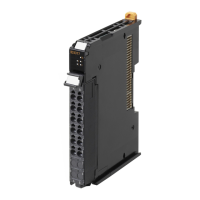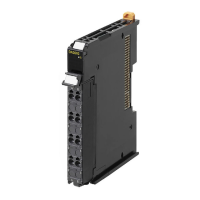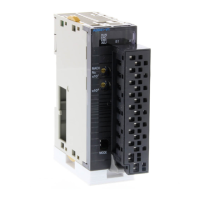4 Installation and Wiring
4 - 44
NX-series Digital I/O Unit User’s Manual (W521)
Precautions when Connecting a Two-wire DC Sensor
When a two-wire sensor is used with a DC Input Unit, check that the following conditions are met.
Failure to meet these conditions may result in operating errors.
(a) Relation between ON voltage of the DC Input Unit and sensor residual voltage
V
ON
≤ V
CC
- V
R
(b) Relation between input current to the DC Input Unit and sensor control output (load current)
I
OUT
(min) ≤ I
ON
≤ I
OUT
(max)
I
ON
= (V
CC
- V
R
- 1.5 [internal residual voltage of DC Input Unit]) / R
IN
When I
ON
is smaller than I
OUT
(min), connect a bleeder resistor R. The bleeder resistor constant can
be calculated as follows:
R ≤ (V
CC
- V
R
) / (I
OUT
(min) - I
ON
)
Power W of bleeder resistor ≥ (V
CC
- V
R
)
2
/ R × 4 [allowable margin]
V
CC
: Input voltage of DC Input Unit
V
R
: Sensor's output residual voltage
I
ON
: Input current of DC Input Unit
I
OUT
: Sensor control output (load current)
R
IN
: Input resistor of DC Input Unit
(c) Relation between OFF current of the DC Input Unit and sensor leakage current
I
OFF
≥ I
leak
When I
leak
is greater than I
OFF
, connect a bleeder resistor R.
Use the following equation to calculate the bleeder resistance constant.
R ≤ R
IN
× V
OFF
/ (I
leak
× R
IN
- V
OFF
)
Power W of bleeder resistor ≥ (V
CC
- V
R
)
2
/ R × 4 [allowable margin]

